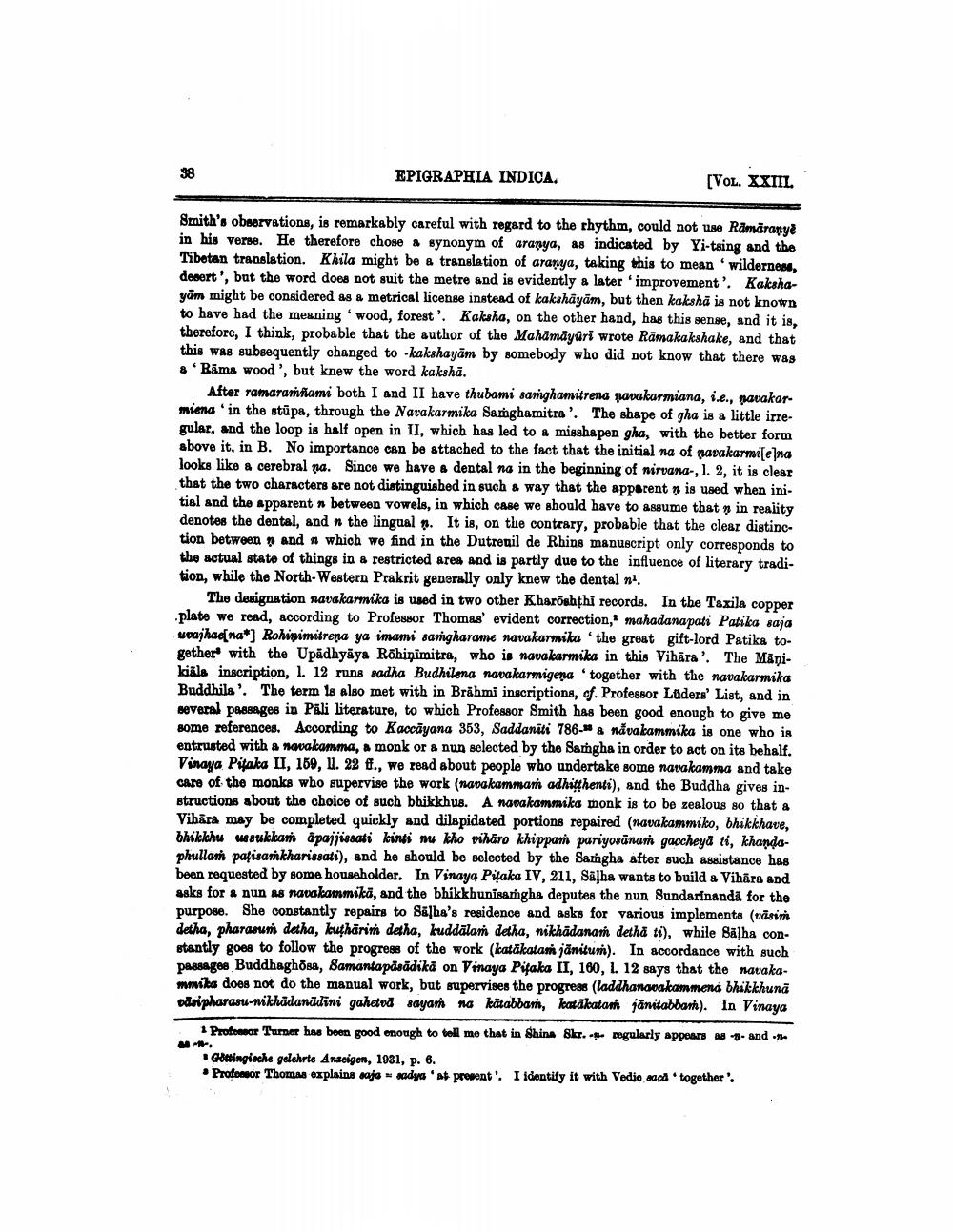________________
EPIGRAPHIA INDICA.
[VOL. XXIIL
Smith's observations, is remarkably careful with regard to the rhythm, could not use Rämäranye in his verse. He therefore chose a synonym of aranya, as indicated by Yi-tsing and the Tibetan translation. Khila might be a translation of aranya, taking this to mean wilderness, desert', but the word does not suit the metre and is evidently a later 'improvement'. Kakshayām might be considered as a metrical license instead of kakshāyām, but then kakshä is not known to have had the meaning 'wood, forest'. Kaksha, on the other hand, has this sense, and it is, therefore, I think, probable that the author of the Mahāmāyüri wrote Rāmakakshake, and that this was subsequently changed to - kakshayām by somebody who did not know that there was 8 'Rāma wood', but knew the word kakshā.
After ramararami both I and II have thubami sanghamitrena pavakarmiana, i.e., navakariena ' in the stūpa, through the Navakarmika Sanghamitra'. The shape of gha is a little irregular, and the loop is half open in II, which has led to a misshapen gha, with the better form above it, in B. No importance can be attached to the fact that the initial na of pavakarmiselna looks like a cerebral na. Since we have a dental na in the beginning of nirvana-, 1. 2, it is clear that the two characters are not distinguished in such a way that the apparent n is used when initial and the apparent n between vowels, in which case we should have to assume that » in reality denotes the dental, and n the lingual . It is, on the contrary, probable that the clear distinction between and n which we find in the Dutreuil de Rhins manuscript only corresponds to the actual state of things in a restricted area and is partly due to the influence of literary tradition, while the North-Western Prakrit generally only knew the dental n.
The designation navakarmika is used in two other Kharoshthi records. In the Taxila copper plate we read, according to Professor Thomas' evident correction, mahadanapati Patika saja woajhae[na*] Rohinimitrena ya imami sangharame navakarmika 'the great gift-lord Patika together with the Upadhyaya Röhipimitra, who is navakarmika in this Vihāra'. The Mänikials inscription, l. 12 runs sadha Budhilena navakarmigena 'together with the navakarmika Buddhils'. The term is also met with in Brahmi inscriptions, of. Professor Lüders' List, and in several passages in Pali literature, to which Professor Smith has been good enough to give me some references. According to Kaccāyana 353, Saddaniti 786-& nåvakammika is one who is entrusted with a novakamma, a monk or & nun selected by the Samgha in order to act on its behalf. Vinaya Pitaka II, 159, 11. 22 ff., we read about people who undertake some navakamma and take care of the monks who supervise the work (napakammam adhitthenti), and the Buddha gives instructions about the choice of such bhikkhus. A navakammika monk is to be zealous so that a Vibāra may be completed quickly and dilapidated portions repaired (navakammiko, bhikkhave, bhikkhu wasukkan äpajjissati kinti mu ktho viharo khippan pariyosānam gaccheya ti, khandaphullari pafisamkharissati), and he should be selected by the Samgha after such assistance has been requested by some householder. In Vinaya Pitaka IV, 211, Sajha wants to build a Vihara and asks for & nun es navakammikā, and the bhikkhunisamgha deputes the nun Sundarfnandã for the purpose. She constantly repairs to Salha's residence and asks for various implements (vāsim detha, pharasuni detha, kuharin datha, kuddāla detha, mikhādanamh detha ti), while Bä]ha constantly goes to follow the progress of the work (katakatam jānitum). In accordance with such passages Buddhaghosa, Samantapăsădika on Vinaya Pifaka II, 160, L. 12 says that the navakammika does not do the manual work, but supervises the progress (laddhangoakammena bhikkhunā odaipharasu-mikhädanādini gahetud sayan na kätabbani, katakatan jānitabbant). In Vinaya
Protonor Turner has been good enough to tell me that in Shina Sk r egularly appears as -- and offe M .
Godingiache gelehrte Anzeigen, 1931, p. 6. • Profesor Thomas explains saja = sadya at present '. I identity it with Vedio and together.




